Pakistan
Coordinates: 30°N 70°E| Islamic Republic of Pakistan |
|
|---|---|

Area controlled by Pakistan shown in dark green; claimed but uncontrolled region shown in light green
|
|
| Capital | Islamabad 33°40′N 73°10′E |
| Largest city | Karachi 24°51′36″N 67°00′36″E |
| Official languages | |
| Recognised regional languages | |
| National language | Urdu[11][12] |
| Ethnic groups | |
| Religion | |
| Demonym | Pakistani |
| Government | Federal parliamentary constitutional republic |
| Mamnoon Hussain | |
| Shahid Khaqan Abbasi | |
| Sadiq Sanjrani | |
| Sardar Ayaz Sadiq | |
| Mian Saqib Nisar | |
| Legislature | Parliament |
| Senate | |
| National Assembly | |
| Independence from the United Kingdom | |
• Dominion
|
14 August 1947 |
| 23 March 1956 | |
| 14 August 1973 | |
| Area | |
• Total
|
881,913 km2 (340,509 sq mi)[a][17] (33rd) |
• Water (%)
|
2.86 |
| Population | |
• 2017 census
|
209,970,000[18] (5th) |
• Density
|
244.4/km2 (633.0/sq mi) (56th) |
| GDP (PPP) | 2017 estimate |
• Total
|
$1.060 trillion[19] (25th) |
• Per capita
|
$5,374[19] (137th) |
| GDP (nominal) | 2017 estimate |
• Total
|
$304.4 billion[20] (42nd) |
• Per capita
|
$1,629[21] (145th) |
| Gini (2013) | 30.7[22] medium |
| HDI (2015) | medium · 147th |
| Currency | Pakistani rupee (₨) (PKR) |
| Time zone | PST (UTC+5b) |
| Drives on the | left[24] |
| Calling code | +92 |
| ISO 3166 code | PK |
| Internet TLD | .pk |
Website
www |
|
|
|
The territory that now constitutes Pakistan was the site of several ancient cultures, including the Mehrgarh of the Neolithic and the Bronze Age Indus Valley Civilisation, and was later home to kingdoms ruled by people of different faiths and cultures, including Hindus, Indo-Greeks, Muslims, Turco-Mongols, Afghans, and Sikhs. The area has been ruled by numerous empires and dynasties, including the Persian Achaemenid Empire, Alexander III of Macedon, the Indian Mauryan Empire, the Arab Umayyad Caliphate, the Gupta Empire,[25] the Delhi Sultanate, the Mongol Empire, the Mughal Empire, the Afghan Durrani Empire, the Sikh Empire (partially), and, most recently, the British Empire.
Pakistan is the only country to have been created in the name of Islam.[26][27] As a result of the Pakistan Movement led by Muhammad Ali Jinnah and the subcontinent's struggle for independence, Pakistan was created in 1947 as an independent homeland for Indian Muslims.[28] It is an ethnically and linguistically diverse country, with a similarly diverse geography and wildlife. Initially a dominion, Pakistan adopted a constitution in 1956, becoming an Islamic republic. An ethnic civil war in 1971 resulted in the secession of East Pakistan as the new country of Bangladesh.[29] In 1973 Pakistan adopted a new constitution establishing, alongside its pre-existing parliamentary republic status, a federal government based in Islamabad consisting of four provinces and four federal territories. The new constitution also stipulated that all laws are to conform to the injunctions of Islam as laid down in the Quran and Sunnah.[30]
A regional[31][32][33] and middle power,[34][35][36] Pakistan has the sixth-largest standing armed forces in the world and is also a nuclear power as well as a declared nuclear-weapons state, the second in South Asia and the only nation in the Muslim world to have that status. Pakistan has a semi-industrialised economy with a well-integrated agriculture sector and a growing services sector.[37][38] The Pakistani economy is the 24th-largest in the world in terms of purchasing power and the 41st-largest in terms of nominal GDP (World Bank). It is ranked among the emerging and growth-leading economies of the world,[39][40] and is backed by one of the world's largest and fastest-growing middle class.[41][42]
Pakistan's political history since independence has been characterized by periods of military rule, political instability and conflicts with India. The country continues to face challenging problems, including overpopulation, terrorism, poverty, illiteracy, and corruption.[43][44][45][46] Pakistan is a member of the United Nations, the Non-Aligned Movement, the Organisation of Islamic Cooperation, the Commonwealth of Nations, the Economic Cooperation Organisation, the Shanghai Cooperation Organisation, the South Asian Association for Regional Cooperation, the Developing Eight, and the G20 developing nations, Group of 24, Group of 77, and ECOSOC. It is also an associate member of CERN. Pakistan is a signatory to the Kyoto Protocol, the Paris Agreement, and the International Covenant on Civil and Political Rights.
History
Early and medieval age
Indus Priest King Statue from Mohenjo-Daro
Standing Buddha from Gandhara
At its zenith, the Rai Dynasty (489–632 CE) of Sindh ruled this region and the surrounding territories.[76] The Pala Dynasty was the last Buddhist empire, which, under Dharmapala and Devapala, stretched across South Asia from what is now Bangladesh through Northern India to Pakistan.
The Arab conqueror Muhammad bin Qasim conquered Sindh in 711 CE.[77][78][79][80][81] The Pakistan government's official chronology claims this as the time when the foundation of Pakistan was laid[77][82][83] but the concept of Pakistan came in 19th century.The Early Medieval period (642–1219 CE) witnessed the spread of Islam in the region. During this period, Sufi missionaries played a pivotal role in converting a majority of the regional Buddhist and Hindu population to Islam.[84] These developments set the stage for the rule of several successive Muslim empires in the region, including the Ghaznavid Empire (975–1187 CE), the Ghorid Kingdom, and the Delhi Sultanate (1206–1526 CE). The Lodi dynasty, the last of the Delhi Sultanate, was replaced by the Mughal Empire (1526–1857 CE).
The Mughals introduced Persian literature and high culture, establishing the roots of Indo-Persian culture in the region.[85] From the region of modern-day Pakistan, key cities during the Mughal rule were Lahore and Thatta,[86] both of which were chosen as the site of impressive Mughal buildings.[87] In the early 16th century, the region remained under the Mughal Empire ruled by Muslim emperors.[88] By the early 18th century, increasing European influence contributed to the slow disintegration of the empire as the lines between commercial and political dominance became increasingly blurred.[88]
During this time, the English East India Company had established coastal outposts.[88] Control over the seas, greater resources, technology, and British military protection led the Company to increasingly flex its military muscle, allowing the Company to gain control over the subcontinent by 1765 and sideline European competitors.[89] Expanding access beyond Bengal and the subsequent increased strength and size of its army enabled it to annex or subdue most of region by the 1820s.[88] Many historians see this as the start of the region's colonial period.[88] By this time, with its economic power severely curtailed by the British parliament and itself effectively made an arm of British administration, the Company began more deliberately to enter non-economic arenas such as education, social reform, and culture.[88] Such reforms included the enforcement of the English Education Act in 1835 and the introduction of the Indian Civil Service (ICS).[90] Traditional madrasahs—primary institutions of higher learning for Muslims in the subcontinent—were no longer supported by the English Crown, and nearly all of the madrasahs lost their financial endowmen.
Pakistan Movement
The 1946 elections resulted in the Muslim League winning 90 percent of the seats reserved for Muslims. Thus, the 1946 election was effectively a plebiscite in which the Indian Muslims were to vote on the creation of Pakistan, a plebiscite won by the Muslim League.[105] This victory was assisted by the support given to the Muslim League by the support of the landowners of Sindh and Punjab. The Congress, which initially denied the Muslim League's claim of being the sole representative of Indian Muslims, was now forced to recognise the fact.[105] The British had no alternative except to take Jinnah's views into account as he had emerged as the sole spokesperson of India's Muslims. However, the British did not want India to be partitioned, and in one last effort to prevent it they devised the Cabinet Mission plan.[106]As the cabinet mission failed, the British government announced its intention to end the British Raj in India in 1946–47.[107] Nationalists in British India—including Jawaharlal Nehru and Abul Kalam Azad of Congress, Jinnah of the All-India Muslim League, and Master Tara Singh representing the Sikhs—agreed to the proposed terms of transfer of power and independence in June 1947 with the Viceroy of India, Lord Mountbatten of Burma.[108] As the United Kingdom agreed to the partitioning of India in 1947, the modern state of Pakistan was established on 14 August 1947 (27th of Ramadan in 1366 of the Islamic Calendar), amalgamating the Muslim-majority eastern and northwestern regions of British India.[101] It comprised the provinces of Balochistan, East Bengal, the North-West Frontier Province, West Punjab, and Sindh.[92][108]
In the riots that accompanied the partition in Punjab Province, it is believed that between 200,000 and 2,000,000[109][110][111][112][113][114] people were killed in what some have described as a retributive genocide between the religions[115][116] while 50,000 Muslim women were abducted and raped by Hindu and Sikh men and 33,000 Hindu and Sikh women also experienced the same fate at the hands of Muslims.[117][118][119][120] Around 6.5 million Muslims moved from India to West Pakistan and 4.7 million Hindus and Sikhs moved from West Pakistan to India.[121] It was the largest mass migration in human history.[122][123][124] Dispute over Jammu and Kashmir led to the First Kashmir War in 1948.
Independence and modern Pakistan
The American CIA film on Pakistan made in 1950 examines the history and geography of Pakistan.
"You are free; you are free to go to your temples, you are free to
go to your mosques or to any other place or worship in this State of
Pakistan. You may belong to any religion or caste or creed – that has
nothing to do with the business of the State."
The creation of Pakistan was never fully accepted by many British leaders, among them Lord Mountbatten.[130] Mountbatten clearly expressed his lack of support and faith in the Muslim League's idea of Pakistan.[131] Jinnah refused Mountbatten's offer to serve as Governor-General of Pakistan.[132] When Mountbatten was asked by Collins and Lapierre if he would have sabotaged Pakistan had he known that Jinnah was dying of tuberculosis, he replied 'most probably'.[133]
Maulana Shabbir Ahmad Usmani, a respected Deobandi alim (scholar) who occupied the position of Shaykh al-Islam in Pakistan in 1949, and Maulana Mawdudi of Jamaat-i-Islami played a pivotal role in the demand for an Islamic constitution. Mawdudi demanded that the Constituent Assembly make an explicit declaration affirming the "supreme sovereignty of God" and the supremacy of the shariah in Pakistan.[134]
A significant result of the efforts of the Jamaat-i-Islami and the ulama was the passage of the Objectives Resolution in March 1949. The Objectives Resolution, which Liaquat Ali Khan called the second most important step in Pakistan's history, declared that "sovereignty over the entire universe belongs to God Almighty alone and the authority which He has delegated to the State of Pakistan through its people for being exercised within the limits prescribed by Him is a sacred trust". The Objectives Resolution has been incorporated as a preamble to the constitutions of 1956, 1962, and 1973.[135]
Democracy was stalled by the martial law that had been enforced by President Iskander Mirza, who was replaced by army chief, General Ayub Khan. After adopting a presidential system in 1962, the country experienced exceptional growth until a second war with India in 1965 that led to an economic downturn and wide-scale public disapproval in 1967.[136][137] Consolidating control from Ayub Khan in 1969, President Yahya Khan had to deal with a devastating cyclone that caused 500,000 deaths in East Pakistan.[138]
Signing of the Tashkent Declaration to end hostilities with India in 1965 in Tashkent, USSR, by President Ayub alongside Bhutto (centre) and Aziz Ahmed (left)
Independent researchers estimate that between 300,000 and 500,000 civilians died during this period while the Bangladesh government puts the number of dead at three million,[143] a figure that is now nearly universally regarded as excessively inflated.[144] Some academics such as Rudolph Rummel and Rounaq Jahan say both sides[145] committed genocide; others such as Richard Sisson and Leo E. Rose believe there was no genocide.[146] In response to India's support for the insurgency in East Pakistan, preemptive strikes on India by Pakistan's air force, navy, and marines sparked a conventional war in 1971 that resulted in an Indian victory and East Pakistan gaining independence as Bangladesh.[140]
With Pakistan surrendering in the war, Yahya Khan was replaced by Zulfikar Ali Bhutto as president; the country worked towards promulgating its constitution and putting the country on the road to democracy. Democratic rule resumed from 1972 to 1977—an era of self-consciousness, intellectual leftism, nationalism, and nationwide reconstruction.[147] In 1972 Pakistan embarked on an ambitious plan to develop its nuclear deterrence capability with the goal of preventing any foreign invasion; the country's first nuclear power plant was inaugurated in that same year.[148][149] Accelerated in response to India's first nuclear test in 1974, this crash program was completed in 1979.[149]
Democracy ended with a military coup in 1977 against the leftist PPP, which saw General Zia-ul-Haq become the president in 1978. From 1977 to 1988, President Zia's corporatisation and economic Islamisation initiatives led to Pakistan becoming one of the fastest-growing economies in South Asia.[150] While building up the country's nuclear program, increasing Islamisation,[151] and the rise of a homegrown conservative philosophy, Pakistan helped subsidise and distribute US resources to factions of the mujahideen against the USSR's intervention in communist Afghanistan.[152][153] Pakistan's North-West Frontier Province became a base for the anti-Soviet Afghan fighters, with the province's influential Deobandi ulama playing a significant role in encouraging and organising the 'jihad'.[154]
President Zia died in a plane crash in 1988, and Benazir Bhutto, daughter of Zulfikar Ali Bhutto, was elected as the country's first female Prime Minister. The PPP was followed by conservative Pakistan Muslim League (N), and over the next decade the leaders of the two parties fought for power, alternating in office while the country's situation worsened; economic indicators fell sharply, in contrast to the 1980s. This period is marked by prolonged stagflation, instability, corruption, nationalism, geopolitical rivalry with India, and the clash of left wing-right wing ideologies.[155][156] As PML(N) secured a supermajority in elections in 1997, Sharif authorised nuclear testings (See:Chagai-I and Chagai-II), as a retaliation to the second nuclear tests ordered by India, led by Prime Minister Atal Bihari Vajpayee in May 1998.[157]
President George W. Bush meets with President Musharraf in Islamabad during his 2006 visit to Pakistan.
After the assassination of Benazir Bhutto in 2007, the PPP secured the most votes in the elections of 2008, appointing party member Yousaf Raza Gillani as Prime Minister.[162] Threatened with impeachment, President Musharraf resigned on 18 August 2008, and was succeeded by Asif Ali Zardari.[163][164][165] Clashes with the judicature prompted Gillani's disqualification from the Parliament and as the Prime Minister in June 2012.[166] By its own financial calculations, Pakistan's involvement in the war on terrorism has cost up to ~$118 billion,[167] sixty thousand casualties and more than 1.8 million displaced civilians.[168] The general election held in 2013 saw the PML(N) almost achieve a supermajority, following which Nawaz Sharif was elected as the Prime Minister, returning to the post for the third time in fourteen years, in a democratic transition..
Role of Islam in Pakistan
The idea of Pakistan, which had received overwhelming popular support among Indian Muslims, especially those in the provinces of British India where Muslims were in a minority such as the United Provinces.,[170] was articulated in terms of an Islamic state by the Muslim League leadership, the ulama (Islamic clergy) and Jinnah.[171] Jinnah had developed a close association with the ulama and upon his death was described by one such alim, Maulana Shabbir Ahmad Usmani, as the greatest Muslim after Aurangzeb and as someone who desired to unite the Muslims of the world under the banner of Islam.[172][173]The Objectives Resolution in March 1949, which declared God as the sole sovereign over the entire universe, represented the first formal step to transform Pakistan into an Islamic state.[174][135] Muslim League leader Chaudhry Khaliquzzaman asserted that Pakistan could only truly become an Islamic state after bringing all believers of Islam into a single political unit.[175] Keith Callard, one of the earliest scholars on Pakistani politics, observed that Pakistanis believed in the essential unity of purpose and outlook in the Muslim world and assumed that Muslim from other countries would share their views on the relationship between religion and nationality.[176]
The Friday Prayers at the Badshahi Mosque in Lahore
The strongest opposition to the Islamist ideological paradigm being imposed on the state came from the Bengali Muslims of East Pakistan[179] whose educated class, according to a survey by social scientist Nasim Ahmad Jawed, preferred secularism and focused on ethnic identity unlike educated West Pakistanis who tended to prefer an Islamic identity.[180] The Islamist party Jamaat-e-Islami considered Pakistan to be an Islamic state and believed Bengali nationalism to be unacceptable. In the 1971 conflict over East Pakistan the Jamaat-e-Islami fought the Bengali nationalists on the Pakistan Army's side.[181]
After Pakistan's first ever general elections the 1973 Constitution was created by an elected Parliament.[182] The Constitution declared Pakistan an Islamic Republic and Islam as the state religion. It also stated that all laws would have to be brought into accordance with the injunctions of Islam as laid down in the Quran and Sunnah and that no law repugnant to such injunctions could be enacted.[30] The 1973 Constitution also created certain institutions such as the Shariat Court and the Council of Islamic Ideology to channel the interpretation and application of Islam.[183]
Pakistan's leftist Prime Minister Zulfikar Ali Bhutto faced vigorous opposition which coalesced into a movement united under the revivalist banner of Nizam-e-Mustafa ("Rule of the prophet")[184] which aimed to establish an Islamic state based on Sharia laws. Bhutto agreed to some Islamist demands before being overthrown in a coup.[185]
After taking power from Bhutto in a coup de'tat, General Zia-ul-Haq, who came from a religious background,[186] committed himself to establishing an Islamic state and enforcing sharia law.[185] Zia established separate Shariat judicial courts[187] and court benches[188][189] to judge legal cases using Islamic doctrine.[190] Zia bolstered the influence of the ulama (Islamic clergy) and the Islamic parties.[190] Zia-ul-Haq forged a strong alliance between the military and Deobandi institutions[191] and even though most Barelvi ulama[192] and only a few Deobandi scholars had supported Pakistan's creation, Islamic state politics came to be mostly in favour of Deobandi (and later Ahl-e-Hadith/Salafi) institutions instead of Barelvi.[193] Sectarian tensions increased with Zia's anti-Shia policies.[194]
According to a PEW opinion poll a majority of Pakistanis support making Sharia the official law of the land.[195] In a survey of several Muslim countries, the PEW Research Centre also found that Pakistanis tend to identify with their religion more than their nationality in contrast to Muslims in other nations such as Egypt, Indonesia and Jordan.
Government and politics
Pakistan's political experience is essentially related to the struggle of Indian Muslims to regain the power they lost to British colonisation.[221] Pakistan is a democratic parliamentary federal republic, with Islam as the state religion.[14] The first constitution was adopted in 1956 but suspended by Ayub Khan in 1958, who replaced it with the second constitution in 1962.[101] A complete and comprehensive constitution was adopted in 1973—it was suspended by Zia-ul-Haq in 1977 but reinstated in 1985—is the country's most important document, laying the foundations of the current government.[199] The Pakistani military establishment has played an influential role in mainstream politics throughout Pakistan's political history.[101] The periods 1958–1971, 1977–1988, and 1999–2008 saw military coups that resulted in the imposition of martial law and military commanders who governed as de facto presidents.[222] Today Pakistan has a multi-party parliamentary system with clear division of powers and checks and balances among the branches of government. The first successful democratic transition occurred in May 2013. Politics in Pakistan is centred on, and dominated by, a homegrown social philosophy comprising a blend of ideas from socialism, conservatism, and the third way. As of the general elections held in 2013, the three main political parties in the country are: the centre-right conservative Pakistan Muslim League-N; the centre-left socialist PPP; and the centrist and third-way Pakistan Movement for Justice (PTI).- Head of State: The President, who is elected by an Electoral College is the ceremonial head of the state and is the civilian commander-in-chief of the Pakistan Armed Forces (with the Chairman Joint Chiefs of Staff Committee as principal military adviser), but military appointments and key confirmations in the armed forces are made by the Prime Minister after reviewing the reports on candidates' merit and performance. Almost all appointed officers in the judicature, military, chairman joint chiefs, and joint staff, and legislature require the executive confirmation from the Prime Minister, whom the President must consult, by law. However, the powers to pardon and grant clemency lie with the President of Pakistan.
- Legislative: The bicameral legislature comprises a 100-member Senate (upper house) and a 342-member National Assembly (lower house). Members of the National Assembly are elected through the first-past-the-post system under universal adult suffrage, representing electoral districts known as National Assembly constituencies. According to the constitution, the 70 seats reserved for women and religious minorities are allocated to the political parties according to their proportional representation. Senate members are elected by provincial legislators, with all the provinces having equal representation.
- Executive: The Prime Minister is usually the leader of the majority rule party or a coalition in the National Assembly— the lower house. The Prime Minister serves as the head of government and is designated to exercise as the country's chief executive. The Prime Minister is responsible for appointing a cabinet consisting of ministers and advisers as well as running the government operations, taking and authorising executive decisions, appointments and recommendations that require executive confirmation of the Prime Minister.
- Provincial governments: Each of the four province has a similar system of government, with a directly elected Provincial Assembly in which the leader of the largest party or coalition is elected Chief Minister. Chief Ministers oversees the provincial governments and head the provincial cabinet, it is common in Pakistan to have different ruling parties or coalitions in each provinces. The provincial assemblies have power to make laws and approve provincial budget which is commonly presented by the provincial finance minister every fiscal year. Provincial governors who play role as the ceremonial head of province are appointed by the President.[199]
Administrative divisions
| Administrative Division | Capital | Population |
|---|---|---|
| Quetta | 12,344,408 | |
| Lahore | 110,012,442 | |
| Karachi | 47,886,051 | |
| Peshawar | 30,523,371 | |
| Gilgit | 1,800,000 | |
| 5,001,676 | ||
| Muzaffarabad | 4,567,982 | |
| Islamabad Capital Territory | Islamabad | 2,851,868 |
The local government system consists of a three-tier system of districts, tehsils, and union councils, with an elected body at each tier.[287] There are about 130 districts altogether, of which Azad Kashmir has ten[288] and Gilgit–Baltistan seven.[289] The Tribal Areas comprise seven tribal agencies and six small frontier regions detached from neighbouring districts.[290]
Clickable map of the four provinces and four federal territories of Pakistan.
Law enforcement is carried out by a joint network of the intelligence community with jurisdiction limited to the relevant province or territory. The National Intelligence Directorate coordinates the information intelligence at both federal and provincial level; including the FIA, IB, Motorway Police, and paramilitary forces such as the Pakistan Rangers and the Frontier Corps.[291]
Pakistan's "premier" intelligence agency, the Inter-Services Intelligence (ISI), was formed just within a year after the Independence of Pakistan in 1947.[292] Pakistan's ISI was ranked as the top intelligence agency in the world in 2011 by the International Business Times UK.[293] ABC News Point in 2014 also reported that the ISI was ranked as the top intelligence agency in the world[294] while Zee News reported the ISI as ranking fifth among the world's most powerful intelligence agencies.[295]
The court system is organised as a hierarchy, with the Supreme Court at the apex, below which are High Courts, Federal Shariat Courts (one in each province and one in the federal capital), District Courts (one in each district), Judicial Magistrate Courts (in every town and city), Executive Magistrate Courts, and civil courts. The Penal code has limited jurisdiction in the Tribal Areas, where law is largely derived from tribal customs.[291][296]
Kashmir conflict
The areas shown in green are the Pakistani-controlled areas.
Azad Kashmir is part of Pakistan-controlled Kashmir.
Pakistan claims that its position is for the right of the people of Jammu and Kashmir to determine their future through impartial elections as mandated by the United Nations,[305] while India has stated that Kashmir is an integral part of India, referring to the Simla Agreement (1972) and to the fact that elections take place regularly.[306] In recent developments, certain Kashmiri independence groups believe that Kashmir should be independent of both India and Pakistan.[233]
Law enforcement
The law enforcement in Pakistan is carried out by joint network of several federal and provincial police agencies. The four provinces and the Islamabad Capital Territory (ICT) each have a civilian police force with jurisdiction extending only to the relevant province or territory.[199] At the federal level, there are a number of civilian intelligence agencies with nationwide jurisdictions including the Federal Investigation Agency (FIA), Intelligence Bureau (IB), and the Motorway Patrol, as well as several paramilitary forces such as the National Guards (Northern Areas), the Rangers (Punjab and Sindh), and the Frontier Corps (Khyber Pakhtunkhwa and Balochistan).The most senior officers of all the civilian police forces also form part of the Police Service, which is a component of the civil service of Pakistan. Namely, there are four provincial police service including the Punjab Police, Sindh Police, Khyber-Pakhtunkhwa Police, and the Balochistan Police; all headed by the appointed senior Inspector-Generals. The ICT has its own police component, the Capital Police, to maintain law and order in the capital. The CID bureaus are the crime investigation unit and forms a vital part in each provincial police service.
The law enforcement in Pakistan also has a Motorway Patrol which is responsible for enforcement of traffic and safety laws, security and recovery on Pakistan's inter-provincial motorway network. In each of provincial Police Service, it also maintains a respective Elite Police units led by the NACTA—a counter-terrorism police unit as well as providing VIP escorts. In the Punjab and Sindh, the Pakistan Rangers are an internal security force with the prime objective to provide and maintain security in war zones and areas of conflict as well as maintaining law and order which includes providing assistance to the police.[307] The Frontier Corps serves the similar purpose in Khyber-Pakhtunkhwa, and the Balochistan
Military
Pakistan Air Force's JF-17 Thunder flying in front of the 26,660-foot-high (8,130-metre) Nanga Parbat.
The Chairman Joint Chiefs of Staff Committee is the highest principle staff officer in the armed forces, and the chief military adviser to the civilian government though the chairman has no authority over the three branches of armed forces.[309] The Chairman joint chiefs controls the military from the JS HQ and maintains strategic communications between the military and the civilian government.[309] As of 2017, the CJCSC is General Zubair Hayat alongside chief of army staff General Qamar Javed Bajwa,[311] chief of naval staff Admiral Muhammad Zaka,[312] and chief of air staff Air Chief Marshal Suhail Aman.[313] The main branches are the Army–Air Force–Navy–Marines, which are supported by the number of paramilitary forces in the country.[314] Control over the strategic arsenals, deployment, employment, development, military computers and command and control is a responsibility vested under the National Command Authority which oversaw the work on the nuclear policy as part of the credible minimum deterrence.[157]
The United States, Turkey, and China maintain close military relations and regularly export military equipment and technology transfer to Pakistan.[315] Joint logistics and major war games are occasionally carried out by the militaries of China and Turkey.[314][316][317] Philosophical basis for the military draft is introduced by the Constitution in times of emergency, but it has never been imposed.[318]
Military history
Since 1947 Pakistan has been involved in four conventional wars, the first war occurred in Kashmir with Pakistan gaining control of Western Kashmir, (Azad Kashmir and Gilgit–Baltistan), and India retaining Eastern Kashmir (Jammu and Kashmir). Territorial problems eventually led to another conventional war in 1965; over the issue of Bengali refugees that led to another war in 1971 which resulted in Pakistan's unconditional surrender in East Pakistan.[319] Tensions in Kargil brought the two countries at the brink of war.[158] Since 1947 the unresolved territorial problems with Afghanistan saw border skirmishes which was kept mostly at the mountainous border. In 1961, the military and intelligence community repelled the Afghan incursion in the Bajaur Agency near the Durand Line border.[320][321]Rising tensions with neighbouring USSR in their involvement in Afghanistan, Pakistani intelligence community, mostly the ISI, systematically coordinated the US resources to the Afghan mujahideen and foreign fighters against the Soviet Union's presence in the region. Military reports indicated that the PAF was in engagement with the Soviet Air Force, supported by the Afghan Air Force during the course of the conflict;[322] one of which belonged to Alexander Rutskoy.[322] Apart from its own conflicts, Pakistan has been an active participant in United Nations peacekeeping missions. It played a major role in rescuing trapped American soldiers from Mogadishu, Somalia, in 1993 in Operation Gothic Serpent.[323][324][325] According to UN reports, the Pakistani military are the third largest troop contributors to UN peacekeeping missions after Ethiopia and India.[326][327]
Pakistan has deployed its military in some Arab countries, providing defence, training, and playing advisory roles.[328][329] The PAF and Navy's fighter pilots have voluntarily served in Arab nations' militaries against Israel in the Six-Day War (1967) and in the Yom Kippur War (1973). Pakistan's fighter pilots shot down ten Israeli planes in the Six-Day War.[323] In the 1973 war one of the PAF pilots, Flt. Lt. Sattar Alvi (flying a MiG-21), shot down an Israeli Air Force Mirage and was honoured by the Syrian government.[330][331][332] Requested by the Saudi monarchy in 1979, Pakistan's special forces units, operatives, and commandos were rushed to assist Saudi forces in Mecca to lead the operation of the Grand Mosque. For almost two weeks Saudi Special Forces and Pakistani commandos fought the insurgents who had occupied the Grand Mosque's compound.[333][334][335] In 1991 Pakistan got involved with the Gulf War and sent 5,000 troops as part of a US-led coalition, specifically for the defence of Saudi Arabia.[336]
Despite the UN arms embargo on Bosnia, General Javed Nasir of the ISI airlifted anti-tank weapons and missiles to Bosnian mujahideen which turned the tide in favour of Bosnian Muslims and forced the Serbs to lift the siege. Under Nasir's leadership the ISI was also involved in supporting Chinese Muslims in Xinjiang Province, rebel Muslim groups in the Philippines, and some religious groups in Central Asia.[337][338]
Since 2004 the military has been engaged in a war in North-West Pakistan, mainly against the homegrown Taliban factions.[339][340] Major operations undertaken by the army include Operation Black Thunderstorm, Operation Rah-e-Nijat and Operation Zarb-e-Azb.[341][342]
According to SIPRI, Pakistan was the 9th largest recipient and importer of arms between 2012–2016.






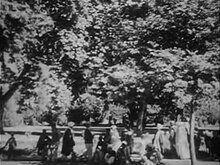


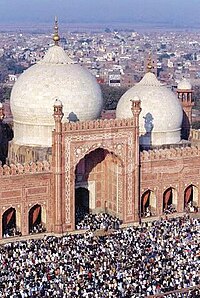
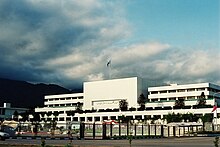


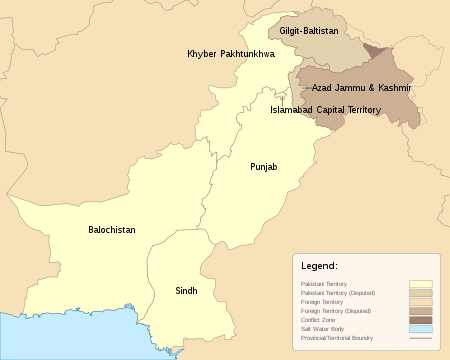

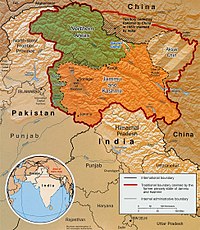
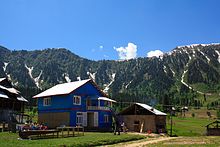

No comments:
Post a Comment